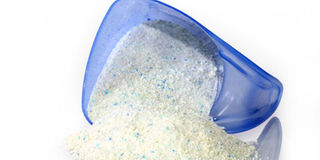Ariel washes Omo from top spot as consumers’ favourite

PHOTO | FILE
What you need to know:
- Survey says that four years after re-entry, detergent is now the leading choice among customers in the Kenyan market
Four years after its re-entry into Kenya, Proctor & Gamble’s washing detergent, Ariel, has edged out Unilever’s Omo from the market leader position.
According to a survey carried out by Consumer Insight Africa, Ariel now controls 25 per cent of the market while Omo holds 18 per cent.
“Going by the results of the newest REJA shopper study from Consumer Insight, Ariel has successfully captured a loyal following,” said Consumer Insight.
Ariel’s coup is reflective of a competition that is gathering steam in the fast-moving goods markets as multinationals and local firms battle it out to capture Kenya’s growing consumer base.
In 1998, Proctor & Gamble introduced Ariel to Kenya, only to slink out following a bruising battle with the Anglo-Dutch Unilever.
In 2009, P&G made a grand re-entry ready to splurge heavily on marketing and with a strategy to gain market leadership in five years.
Nearly four years and one price war later, the company appears to have achieved its growth ambitions.
However, Unilever may yet have the last laugh. According to Consumer Insight, although Ariel is now the market leader, a combination of Unilever brands still control the largest chunk of the market.
Sunlight detergent, Unilever’s answer to the low-end market, now has a market share of 17 per cent. This, combined with Omo’s market share means that Unilever holds 35 per cent of the laundry detergent market, well above P&G’s 25 per cent.
“But Omo and Sunlight — both from the multinational — have a combined share that more than beats what Number One (Ariel) controls. This proves that a multiple brand strategy within one category is actually workable,” said Consumer Insight.
Nevertheless, this is a step-down for Unilever, whose Omo has been a market leader for more than four decades. Research firm AC Nielsen in 2009 reported that Unilever controlled 50 per cent of the market.
Reasonable position
Kapa Oil’s Toss detergent came in fourth with a six per cent market share, tying with PZ Cussons’ Ushindi bar soap.
“Coming in at a respectable position is Ushindi, whose brand is based on the broad appeal at the mid to upper class. This simple fact alone makes it the brand to watch in this segment,” said Consumer Insight.
Bidco’s Gental and Power Boy had four per cent and three per cent market share respectively.
Trends in the detergent market are replicated across other segments of the fast-moving consumer goods sector where multinationals have bitten a larger piece of the pie of local industries.
Consumer Insight surveys on market share of product categories ranging from bathing soap to spices and sanitary towels show that multinationals, led by P&G and Unilever, are leading the pack.
The research firm notes that brands that are easily recognisable and which have been in the market for decades still hold sway among consumers.
In the sanitary towels division, P&G’s Always holds a 62 per cent market share and Consumer Insight warns that it will be extremely expensive for any other brand to topple it from this position.
“With a consistent marketing formula — target the youth, execute relentlessly, grow with your market — the brand has successfully engaged its core audience. This dominance, a lead of over 51 per cent, is costly to overcome, so not worth the effort,” writes the research firm.
Advertising benefit
Other brands that have benefited from advertising include Unilever’s Royco, which was ranked as having the second best television commercial last year. Unilever dominated the list of most memorable advertisements following a survey of 12,000 television and radio commercials.
Blue Band, remained a favourite in the spreadable oils and fats segment, capturing about 76 per cent of the market. The brand beat Kapa Oil’s Prestige Margarine and Bidco Oil’s Biddy, also buoyed by strategic advertising.
Although the big spenders in advertising are multinationals, Consumer Insight found that the utilisation of Kenyan advertising agencies and artists made a crucial difference in the effectiveness of the advertisement.
However, some locally produced adverts were also ranked among the worst performers.




